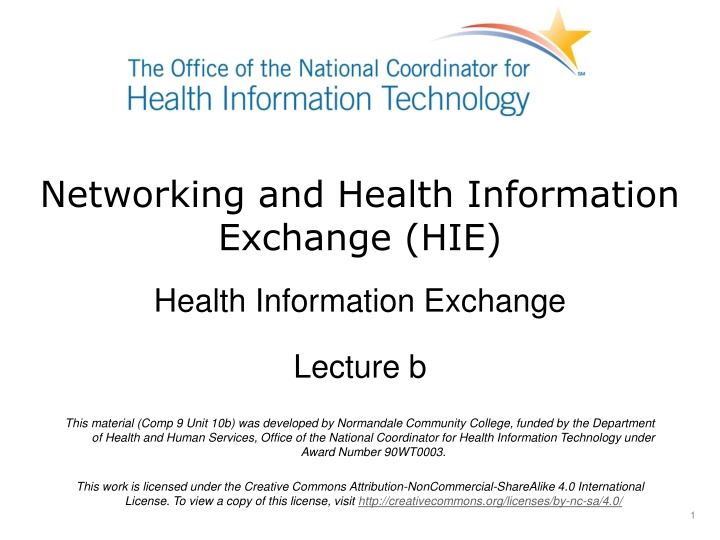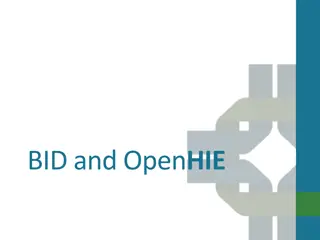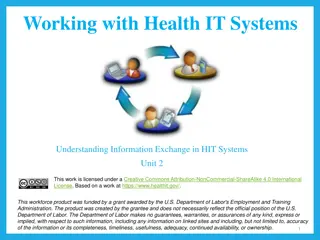Health Information Exchange (HIE) Overview
Highlighting the key aspects of Health Information Exchange (HIE) including its definition, benefits/risks, interoperability, and future trends. Learn about its role in securely sharing medical data for improved healthcare outcomes.
Download Presentation

Please find below an Image/Link to download the presentation.
The content on the website is provided AS IS for your information and personal use only. It may not be sold, licensed, or shared on other websites without obtaining consent from the author.If you encounter any issues during the download, it is possible that the publisher has removed the file from their server.
You are allowed to download the files provided on this website for personal or commercial use, subject to the condition that they are used lawfully. All files are the property of their respective owners.
The content on the website is provided AS IS for your information and personal use only. It may not be sold, licensed, or shared on other websites without obtaining consent from the author.
E N D
Presentation Transcript
Networking and Health Information Exchange (HIE) Health Information Exchange Lecture b This material (Comp 9 Unit 10b) was developed by Normandale Community College, funded by the Department of Health and Human Services, Office of the National Coordinator for Health Information Technology under Award Number 90WT0003. This work is licensed under the Creative Commons Attribution-NonCommercial-ShareAlike 4.0 International License. To view a copy of this license, visit http://creativecommons.org/licenses/by-nc-sa/4.0/ 1
Health Information Exchange Learning Objectives Clarify that HIE is both a noun and a verb. Identify benefits/risks of HIE for patients, providers, government and specific benefits for rural health. Describe the push and pull methods of moving data and give an example of each. Identify benefits/risks of HIE for patients, providers, government Contrast the difference between syntactic and semantic interoperability. 2
Objectives (cont.) Describe how the major advantage of the centralized model over point to point interoperability. Identify the various acronyms describing the structure of HIE: NwHIN, PCMH, ACO, IHE, FHIR. Understand the features to ask an EHR vendor provide effective HIE. Discuss future trends for HIE. 3
Health Information Exchange (HIE) Health care providers and patients can appropriately access and securely share personal vital medical information electronically. Goals: Avoid readmissions Avoid medication errors Improve diagnoses Decrease duplicate testing Source: Healthit.gov 4
Defining HIE Verb and Noun Mobilization of healthcare information electronically across organizations (Verb) Entity that facilitates the exchange (Noun) Goal: facilitate access to and retrieval of clinical data to provide safer and more timely, efficient, effective, and equitable patient-centered care. 5
Moving data: Push/Pull Push: secure sending of information between two known entities Direct Project Pull: secure accessing of information that involves a query and a response CONNECT 6
Direct and Connect Point to Point Specifies a simple, secure, scalable, standards-based method to send authenticated, encrypted health information directly to known, trusted recipients over the Internet, using third parties such as DirectTrust http://directproject.org/ Broader multiple entities Open source software gateway that allows health organizations to securely exchange health-related information connecting multiple stakeholders. http://www.connectopensource.org 7
Benefits of HIE: Providers Emergency Care Public health reporting and monitoring Improved Care / Fewer Medical Errors Clinical Decision Support Tracking Access to Information Less Redundant of Unnecessary Services Reduced Costs 8
Benefits of HIE: Patients Consumer Education and Patient Involvement Improved payment coordination Improved clinical outcomes Improved transitions of care Reduced or eliminated duplicate procedures Improved visit experience and satisfaction 9
Benefits of HIE: Government/Public Health Improved understanding of patients clinical needs Improves Public Health Reporting /Monitoring More timely access to public health and population health data Supports Medicaid in developing programs to improve health of residents Source: District of Columbia Department of Healthcare Finance 10
Benefits of HIE- Rural Timely real-time access to health information Decreased travel time for patients /families Extended access to remote clinicians, pharmacists Efficient transfer for services not offered locally Efficient local care after intense care in a tertiary hospital 11
Patient Consent State and federal law decides if patents have the option to opt in or out of exchange: Opt-in State None of your data is shared unless you opt-in to the program Opt-out State Patient s data automatically is available to the HIE unless they opt-out 12
Risks of HIE Identity Theft Hackers Errors Complexity Cost 13
Defining Interoperability Interoperability involves exchanging key pieces of health information securely, with the goal of being to obtain and share the right information in the right context. Meaningful Use data set: http://ccda.sitenv.org/Common+MU+Data+Set Vocabulary & Code Sets (Snomed, ICD9 or10) Content Structure Transport Security Services 14
Healthcare Interoperability: Terms Interoperability: The ability of diverse systems to work together. Two types of Interoperability 1. Syntactic: The ability of computer systems to communicate and exchange data. 2. Semantic: The ability of computer systems to meaningfully interpret the information exchanged. 15
Big Picture: NwHIN Nationwide Health Information Network Current pronunciation: New HIN - Also known as the NHIN NwHIN Connect traditional view of inter- connected cells NHIN Direct aka Direct Project, considered NwHIN lite; idea is ease of adoption ARRA funded American Recovery and Reinvestment Act Syndromic Surveillance - 9/11/2001 as a driving factor 18
IHE Development Domains Integrating Healthcare Enterprise 20
Vendor Questions to Facilitate HIE Are there HIE capabilities within our EHR? Privacy/security features present / supported Form(s) of exchange Cost of upgrading to include HIE Maintenance costs of including HIE functionality Timeframe for availability if not available now 21
Interoperability & HIE Review of HIE: HIE the verb the Exchange of Health Information HIE the nouns: (HIE) Health Information Exchanges (RHIO) Regional Health Information Organizations (ACO) Accountable Care Organizations (PCMH) Patient Centered Medical Homes 22
New Term Spreading Like WildFHIR Fast Healthcare Interoperable Resource FHIR combines the best features of: HL7v2, HL7v3, CDA FHIR leverages latest web service technologies FHIR utilizes REST in contrast to SOAP web services FHIR s modular components bring practical solutions HL7 International: Draft Standard for Trial Use (DSTU) 23
Future of HIE Seamless secure exchange of information among diverse systems (global) Providers have instant access to patient key data Blurred lines between the hospital and vendor NwHIN infrastructure operating State Designated Entities (SDE s) will evolve into regional entities (not necessarily be governed by geographical boundaries) 24
In Summary Defined HIE and Interoperability Benefits and Risks of HIE Basic terminology of interoperability & data exchange Highlighted the structure of HIE entities Shared some future expectations for HIE 25
References References Health information exchange. (2017). Retrieved 2017, from Wikipedia website. Minnesota e-Health. (2017). Retrieved 2017, from Minnesota e-Health website. Connect Open Source. (2017). FAQ. Retrieved 2017, from Connect Open Source website. Interoperability Basics. (n.d.). Retrieved 2017, from ONC website. Getting Started with HIE. (n.d.). Retrieved 2017, from ONC website. Regional Health Information Organization. (2017). Retrieved 2017, from Wikipedia website. Accountable care organization. (2017). Retrieved 2017, from Wikipedia website. Medical home. (2017). Retrieved 2017, from Wikipedia website. 26
Health Information Exchange Lecture b This material was developed by Normandale Community College, funded by the Department of Health and Human Services, Office of the National Coordinator for Health Information Technology under Award Number 90WT0003. 27























